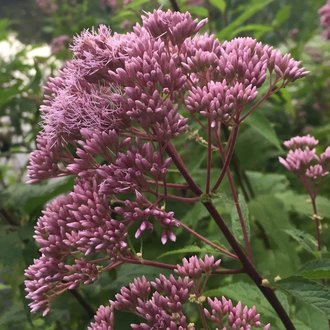Coastal Plain Joe Pye Weed vs Spotted Joe Pye Weed
These species are easily confused where their ranges overlap, from southern New England through New Jersey. Both inhabit wetlands, have spotted stems, and can be on the shorter side among Joe Pye weeds. However, they are usually easily distinguished by inflorescence shape, number of florets per head, and leaf vein pattern, and sometimes bloom color or number of leaves per whorl. E. dubium prefers more acidic habitats, whereas E. maculatum prefers more mineral-rich soil.
Coastal Plain Joe Pye Weed (Eutrochium dubium) | Spotted Joe Pye Weed (Eutrochium maculatum) |
A perennial of moist, sandy, acidic soils native to the coastal plain from New England south through South Carolina. | A perennial of sunny, calcium-rich wetlands, ranging the farthest north of its genus. |
Inflorescence may be flat-topped, but usually more convex, sometimes strongly so. Photo © Matt Schenck, CC BY 4.0. | Inflorescence consistently more flat-topped, never as strongly rounded. Photo © Sean, CC BY 4.0. |
Usually has 4-8 florets per head; individual flowerheads look slimmer. Photo © Alona Bookbinder, CC BY-SA 4.0. | Usually has 9-20 florets per head; individual flowerheads look larger. Photo © Laura Costello, CC BY 4.0. |
Leaves usually have a triple-veined appearance, with two veins branching near the leaf base and extending farther towards the leaf tip. Photo © Becky, Public Domain. | Leaves usually lack a triple-veined appearance; if prominent veins branch near the leaf base, they are not likely to extend as far towards the tip. Photo © Quinten Wiegersma, CC BY 4.0. |
Inflorescence tends to have a more vibrant, saturated color. Photo © Matt Schenck, CC BY 4.0. | Inflorescence tends to have a more washed-out, grayish color. Photo © Shirley Zundell, CC BY 4.0. |
Leaves in whorls of 3-4. Photo © Becky, Public Domain. | Leaves in whorls of 4-5. Photo © Charlie Hohn, CC BY 4.0. |
References & External Resources
These short lists show only links helpful for ID. For a complete list of references and resources also covering other aspects of ecology, visit the links section of the full article on each plant, which is the first entry here.












